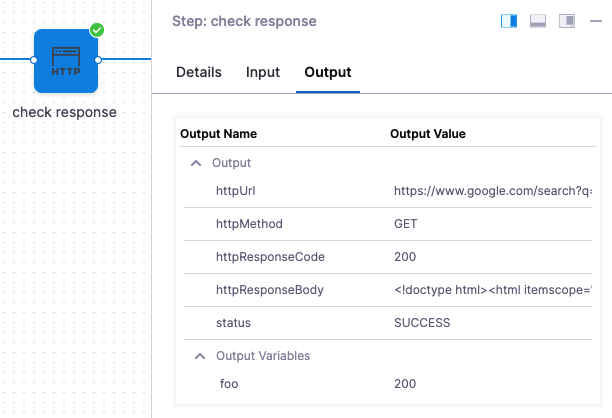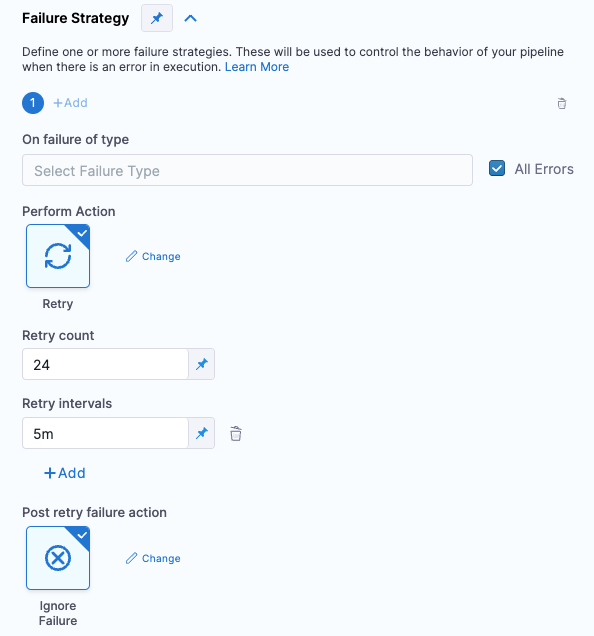HTTP step reference
This topic describes the settings for the HTTP step.
You can use the HTTP step to run HTTP methods containing URLs, methods, headers, assertions, and variables.
Name
The name of the step. You'll use this name when you reference the step settings.
For example, if the step name is HTTP and you want to reference the URL entered in its URL setting, use:
<+pipeline.stages.tooltips.spec.execution.steps.HTTP.spec.url>
Timeout
The timeout for the step. Use:
wfor weeksdfor dayshfor hoursmfor minutessfor secondsmsfor milliseconds
The maximum is 53w.
Timeouts can be set at the pipeline level also.
URL
The URL for the HTTP call.
Method
The HTTP method to use in the step.
Request body
The message body of the HTTP message.
Assertion
Assertion is used to validate the incoming response. For example, if you wanted to check the health of an HTTP connection, use the assertion <+httpResponseCode> == 200.
The expression <+httpResponseCode> == 200 will evaluate to true if the HTTP call returns a 200 code.
Expressions can use the following aliases to refer to the HTTP responses, URL, and method.
<+httpResponseCode><+httpResponseBody>
Headers
Enter the media type for the message. For example, if you are using the GET method, the headers are used to specify the GET response body message type.
In Key, enter Token
In Value, enter <+secrets.getValue("aws-playground_AWS_secret_key")>
Another method:
- Key:
variable: - Value:
var1,var2:var3
You can copy the key and paste it in the HTTP step Header setting. For more information, go to add and manage API keys.
Input variables
Create input variables that can be used by other fields within the step. The Value setting can contain fixed values, expressions, or runtime inputs.
These variables can be used by other fields like URLs by using the following expressions:
<+spec.inputVariables.variable_name> or <+step.spec.inputVariables.variable_name>

Output variables
Create output variables to be used by other steps in the stage. The Value setting can contain any HTTP step input, output, or response information.
You can also use JSON and XML functors in the values for the output variable. For example, <+json.select("data.attributes.version_pins.mvn-service://new-construction-api", httpResponseBody)>.
You can use pipeline variables along with httpResponseBody and httpResponseCode.
Here are some examples:
<+json.object(httpResponseBody).title>
<+json.select(<+pipeline.variables.title>, httpResponseBody)>
To concatenate strings within the JSON functor:
<+json.select(<+ <+pipeline.variables.user> + <+pipeline.variables.id>>,httpResponseBody)> or <+json.select("user".concat(<+pipeline.variables.id>),httpResponseBody)>
For more information, go to JSON and XML functors.
Step execution inputs and outputs
Once you execute your pipeline, the step displays its inputs and outputs and their values.

You can reference these anywhere in your pipeline.
Inputs
In the following examples, the Id of the HTTP step is HTTP.
| Input Name | Input Reference Example | Input Value Example |
|---|---|---|
| identifier | <+pipeline.stages.HTTP.spec.execution.steps.check_response.identifier> | check\_response |
| name | <+pipeline.stages.HTTP.spec.execution.steps.check_response.name> | check response |
| timeout | <+pipeline.stages.HTTP.spec.execution.steps.check_response.timeout> | 10s |
| type | <+pipeline.stages.HTTP.spec.execution.steps.check_response.type> | Http |
| url | <+pipeline.stages.HTTP.spec.execution.steps.check_response.spec.url> | https://www.google.com/search?q= |
| method | <+pipeline.stages.HTTP.spec.execution.steps.check_response.spec.method> | GET |
| requestBody | <+pipeline.stages.HTTP.spec.execution.steps.check_response.spec.requestBody> | current+date |
| assertion | <+pipeline.stages.HTTP.spec.execution.steps.check_response.spec.assertion> | <+httpResponseCode> == 200 |
Outputs
In the following examples, the Id of the HTTP step is HTTP.
| Output | Output Reference Example | Output Value Example |
|---|---|---|
| httpUrl | <+pipeline.stages.HTTP.spec.execution.steps.HTTP.output.httpUrl> | https://www.google.com/search?q= |
| httpMethod | <+pipeline.stages.HTTP.spec.execution.steps.HTTP.output.httpMethod> | GET |
| httpResponseCode | <+pipeline.stages.HTTP.spec.execution.steps.HTTP.output.httpResponseCode> | 200 |
| httpResponseBody | <+pipeline.stages.HTTP.spec.execution.steps.HTTP.output.httpResponseBody> | Hello |
| status | <+pipeline.stages.HTTP.spec.execution.steps.HTTP.output.status> | SUCCESS |
Advanced settings
In Advanced, you can use the following options:
Delegate proxy
HTTP step supports delegate proxy settings by default. For more information, go to delegate proxy settings.
Header capability check
When Harness runs an HTTP step and connects to a service, it checks to make sure that an HTTP connection can be established.
Some services require HTTP headers to be included in connections. Without the headers, the HTTP connections fail and simple HTTP verification cannot be performed.
Harness performs an HTTP capability check with the headers included on the target service.
If the target host server require headers and you do not include headers in the Headers setting of the HTTP step, the Harness delegate will fail the deployment with the error No eligible delegates could perform this task (error 400).
Add the required headers in Headers and run the deployment. Adding the headers will prevent the 400 error.
Harness secrets are not used during capability checks. They are used in actual steps only. If you have a step configured with URLs and multiple headers like:
x-api-key : <+secret.getValue('apikey')>
content-type : application/json
During a capability check, the non-secret headers are used as is but the secret headers are masked. Harness makes the HTTP request with the URL and headers as follows:
x-api-key:<<<api_key>>>
content-type:application/json
This results in a 401 Unauthorized response due to an incorrect api key. However, the capability check will be successful and the task will be assigned to the Harness delegate.
Using <<<and>>> in HTTP requests might result in bad requests on the server side. In such cases, follow these workarounds.
- Use FF
CDS_NOT_USE_HEADERS_FOR_HTTP_CAPABILTYto not use headers for capability checks. - Use Shell script to run cURL command and manually process the response.
Capability checks are basic accessibility checks and do not follow multiple redirects. Hence, Harness returns from the first 302 Found response during capability checks.
HTTP polling
The HTTP step supports polling. When you create the HTTP step for polling, the client requests the resource at regular intervals.
To configure polling in the HTTP step:
In the step, go to Step Parameters > Optional Configuration, and enter the following details:
Assertion (optional): Enter the expression to validate the incoming response. You can use the following aliases to refer to the HTTP responses, URL, and method:
<+httpsResponseCode><+httpUrl><+httpMethod><+httpResponseBody>
Headers (optional): Enter the key and value for the headers in the message.
For example, in Key, enter the token, in Value, enter secret references such as
<+secrets.getValue("aws-playground_AWS_secret_key")>.Output (optional): Create the output steps to be used by other steps in the stage.
The Value setting can contain any HTTP step input, output, or response information. You can also use JSON and XML functors in the value.
In Advanced > Failure Strategy, do the following:
- In On failure of type, select All Errors.
- In Perform Action, select Retry.
- In Retry count, enter the number of times you want the HTTP step to retry reaching the resource.
- In Retry intervals, specify the gap between two successive connection retries.
- In Post retry failure action, select Ignore Failure.

The HTTP step retries polling and ignores all errors until the condition mentioned in the assertion section is met.